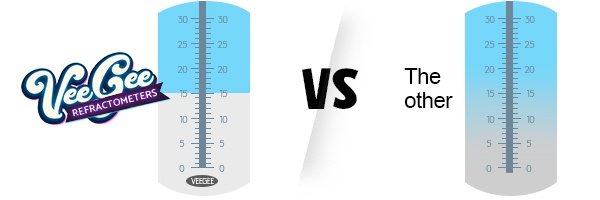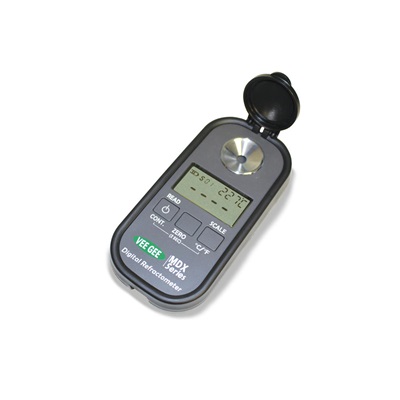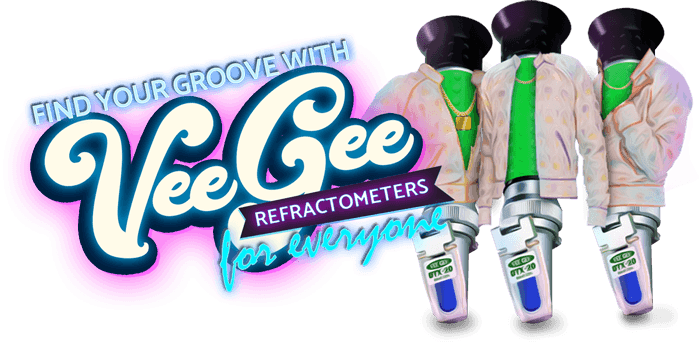Finding the Right Refractometer: Digital or Analog?
How refractometers work, how best to use them, and how to find the right fit for your application
If you want to better understand the science behind your refractometer, then you’re in the right place. And if you recently Googled any variation of the following...
- What is a refractometer?
- How do I use a refractometer? (or maintain it, or calibrate it...)
- Which industries could benefit from a refractometer?
- What’s the difference between an analog refractometer and digital refractometer ?
- What type of refractometer is right for me?
...then you’re definitely in the right place.
We’ll cover the basics of refractometers, the value they bring and the difference between digital and analog refractometers. And we’ll help determine the right fit for various applications.
But if you want to jump right to the best refractometer for your application, you can find them right here. VEE GEE makes some of the best digital and analog refractometers available to home users and professional users alike. They’re professional quality instruments at price points accessible to everyone.

Let's start at the beginning.
What is a refractometer?
A refractometer is a surprisingly simple but highly effective device that you’ll find in labs, field work, businesses, and increasingly even homes. Refractometers are widely used by both hobby users and professionals throughout the food, agriculture, chemical and manufacturing industries, to name just a few.
Simply put, the refractometer is used to measure the concentrations of aqueous solutions. You just need a few drops of liquid from your sample, and you’ll be able to determine the concentration of your solution. We’ll cover how they work, what they measure, where they’re used and what type of refractometer might be right for you.
See the most popular portable refractometersWhat does a refractometer measure?
A refractometer is a device designed to measure something called the index of refraction. It measures the extent of light refraction of transparent substances in either a liquid or solid state. The resulting measurement can be used to do a range of very useful things, including:
- identify a liquid sample
- analyze the sample’s purity
- determine the concentration of dissolved substances within the sample
The reason they’re used in such a range of applications is because your samples vary so greatly. The sample could be beer or wine, where your Brix refractometer would come in handy. It could be a new formula of vegetable juice that your brand has created, with help from your NaCl refractometer to measure the salt content.
Refractometers are available in a variety of scales. A few examples include:
- Salinity: Sometimes called a 'seawater refractometer,' and used to measure the sodium chloride in solutions. (e.g. used for measuring and maintaining saltwater levels in aquariums)
- Coolant: Frequently used in the automobile and machine industry, coolant refractometers measure coolant concentrations to measure the amount of coolant concentrate that’s been added to a sample, and to determine the efficiency of ethylene glycol and propylene glycol in coolants.
- Clinical: Used in medical labs to determine urine specific gravity, protein concentration in plasma and serum protein. For example, used to test for urine drug sample tampering.
- Gemstone refractometer: One of the most important tools in the gemological laboratory, which indicates the refraction index of a gemstone to help identify it.
- Specific gravity: Measures the density of a liquid in relation to water content (which has a specific gravity of 1)
- Brix: Commonly used in the food and beverage industry, Brix refractometers measure the percentage of sucrose (sugar) in solutions. For example, how much sugar is in the new fruit juice you’re manufacturing, or in the wine you’re making.
What is a Brix refractometer?
The term 'Brix refractometer' has likely come up in your Google search. A Brix refractometer is designed to measure the sucrose content (sugar content) of a sample through refraction. Commonly, they're used to measure the percent of sucrose found in vegetables, fruit juice, soft drinks, wine, beer and many other plant-based foods.
This is important, because there’s a direct correlation between a plant’s Brix value and its taste, quality, potential alcohol content, and nutritional density. That’s why Brix refractometers come in a range of designs that are quick and accurate, and are commonly used within the food and beverage industries for quality control.
How does a refractometer work?
So we know the refractometer measures the index of refraction. But how exactly does it work?
When light passes through a liquid from the air, it changes direction, creating a ‘bending’ illusion. This is called refraction. Refractometers measure the degree to which the light changes (or the intensity of the ‘bend’). This is called the angle of refraction.
Solutions have different refractive indexes, depending on their concentration in water. The intensity of the ‘bend’ depends on:
- the composition of the substance
- and the temperature
The amount of substance dissolved in the liquid sample (for example, the amount of sugar in a glass of water, or the amount of salt in seawater).
Thanks to your refractometer, you can calculate the refraction angles of your solution (using Snell’s Law), then correlate them to refractive index values. Using these values, you can calculate the concentration of your solutions. As the concentration of a particular compound in your solution increases, so does the degree to which light is bent.
So thanks to your refractometer, you can calculate the index of refraction, which then allows you to determine the concentration of a mixture.
What industries are using refractometers? What are the benefits?
The list is long! From labs, to field work, to home hobbyists, refractometers are used throughout the food, agriculture, chemical and manufacturing industries.
Some common applications for a refractometer might include:
- Researchers in the food and beverage industries
- Farmers determining the right sucrose levels before harvesting fruit and vegetables
- Lab technicians measuring plasma protein in blood samples
- Quality control in industrial and manufacturing industries
- Gemologists and jewelers identifying stones
This is by no means an exhaustive list. You’ll be surprised how many industries and applications you can think of.
What are some common applications for refractometers?
Here are a few examples of how professional and home users are using refractometers:
- Perfecting that perfect IPA brew at home by measuring the amount of dissolved sugar in your creation (without wasting your precious sample)
- Field testing fruit and vegetables before a harvest, to measure sucrose levels and get the optimal taste and flavor from your farm or garden
- Checking chemical dilution in the automotive industry
- Determining the ripeness of grapes in your vineyard, to produce the perfect wine
- Ensuring the salinity in your saltwater pool or home aquarium is just right so that you (or your fish) can enjoy the water
- Improving your cup of coffee by identifying extraction amounts, and measuring the caffeine concentration in your beans
What makes VEE GEE better?
They’re easy to calibrate (no tools needed), the calibration ring doesn’t twist out of place while you use it. But for most users, it’s the bright, clear display.

Do I need a portable refractometer?
There’s a variety of options to choose from. Across industries, folks are moving away from traditional stationary laboratory refractometers (also called an Abbe refractometer), and opting for a portable refractometer that still provides high accuracy, but takes up less space and costs less.
- Analog handheld refractometer: With an analog handheld refractometer, the sample is placed on a cover plate and prism, and then held up to the light to view the scale inside the meter.
- Digital handheld refractometer: Digital refractometers need a drop of the tested solution to be placed in the well, which is illuminated by a light source. The meter interprets the light transmissions into the refractive index.
We’ve put together a guide below, to help you determine which option might be right for you.
Best Analog Handheld Refractometer:
Portable handheld analog refractometers are a great choice for your work if you need accurate but slightly less precise results at a lower price point. Our top recommendation for an analog refractometer is:

This analog refractometer is exceptionally simple to use and provides quick, accurate measurements for the concentration of nearly any aqueous solution at a uniquely affordable price point.
Most home and hobby users choose this refractometer because it’s built to professional lab-quality standards - so it lasts decades, maintains its accuracy, doesn’t need any fancy calibration tool, and takes up as much space as a screwdriver in a drawer.
Best Portable Digital Refractometer:
Portable digital refractometers could be the right fit for measuring things like wine, sugar and salinity. Our top recommendation for a digital refractometer would be:

This digital refractometer provides digital accuracy and high-end features for specific applications like commercial-scale food & beverage, industrial, waste-water, aquatics, and many more.
This handheld device blends portability with precision. With a large digital display, you’ll get exact readings every time. And it’s designed to make your life easy: it’s compact and lightweight, painlessly easy to maintain and clean, and calibrates within seconds.
Still have questions? Our friendly and knowledgeable team is happy to help you find the right refractometer for your purposes. Contact us about your VEE GEE refractometers
Using, maintaining, and calibrating your refractometer
Now that we’ve determined which refractometer is right for you, let’s dive into how to use it.
Not sure how to use a refractometer?
That’s alright - using a refractometer is simple!
While this process differs based on the type of refractometer you’re using (digital, analog, benchtop), the basic steps are as follows:
- Calibrate the refractometer before using it (see tips below)
- Place several drops of the sample liquid on the angled prism
- Seal the clear plate on top of it to make sure there are no dry spots or air bubbles
- Look through the eyepiece while pointing the refractometer at a source of direct light (just don’t look directly at the light with the naked eye!)
The refractometer’s prism has a greater refractive index than the solution. Read your measurements at the point where the prism and solution meet. With a low concentration solution, the refractive index of the prism is much greater than that of one sample, creating a larger refraction angle and a low reading.
How do I calibrate a refractometer?
Calibration of your analog or digital refractometer is quick and easy.
- Calibrate the refractometer with a distilled water before using it. And since the reading will be affected by temperature changes, it is best to calibrate at the temperature of the test environment (if that’s not possible, correction charts can be used).Some refractometers have automatic temperature correction (ATC), a feature that allows the instrument to automatically correct for temperature differences.
- Place a small amount of liquid (usually 2-5 drops) on the prism and secure the cover plate. This will evenly distribute the liquid on the prism.
- Point the prism end of the refractometer toward a light source and focus the eyepiece until the scale is clearly visible.
- Read the scale value at the point where the dark and light portions meet.
Note: Instructions may vary slightly based on your instrument, so be sure to follow the instructions your device comes with.
How do I maintain my refractometer?
More good news! While highly effective, refractometers are such simple devices that they require very little maintenance. When you’re done with your measurement, just wipe the prism with a soft lens tissue. While not in use, keep the cover closed to avoid scratching or damaging the prism.
Still have questions about your refractometer? Give our team a shout. We’ll be happy to talk VEE GEE refractometers and help you find the best option for your application.
Contact us today and tell us what you need